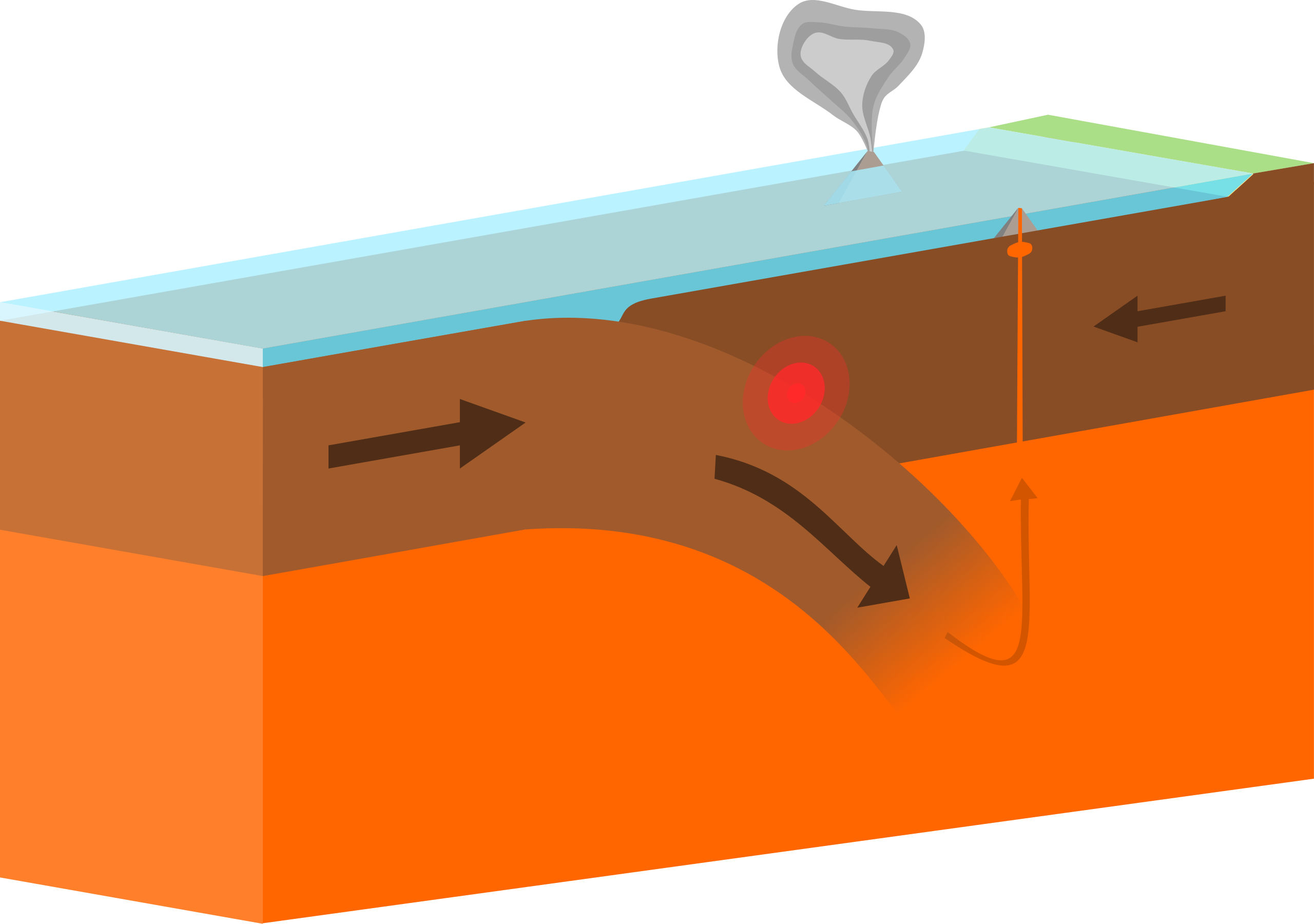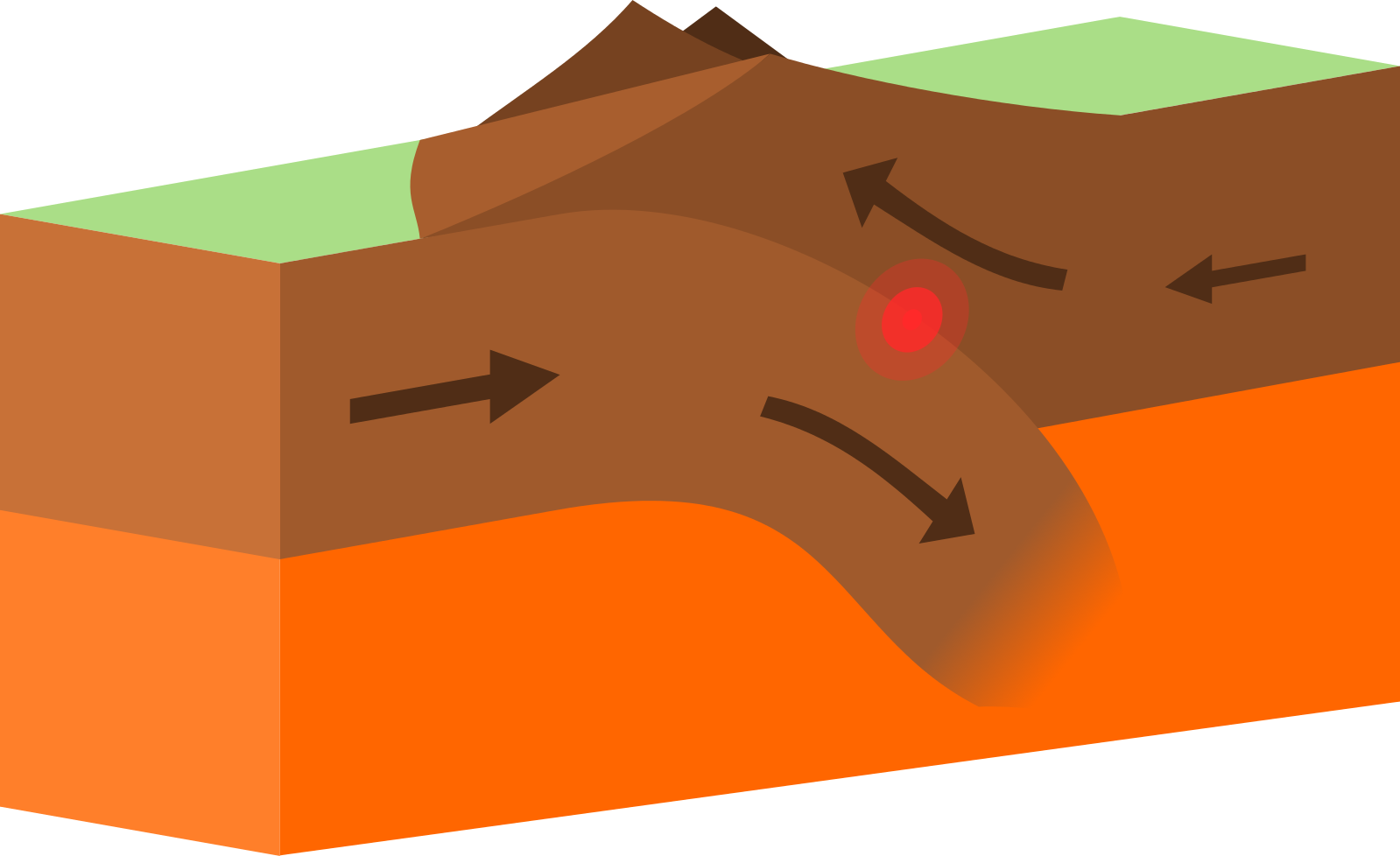
Plate Tectonics |
||
In the first two cases, an oceanic plate is subducted beneath an overriding plate (either continental or oceanic). As the subducting plate descends, the surface starts to melt. This melt rises up to form a chain of volcanoes.
A curved Earth dictates that volcanic belts are curved. The type of arc created depends on the overriding plate.
In this scenario, an oceanic plate collides with a continental plate. Since the oceanic plate is denser (do you remember it's density?), it is the one that subducts. Recall Alfred Wegener's third piece of evidence (Tectonic Fit - Plate Tectonics: Continental Drift page). The Caledonian orogeny formed in two phases. The first occurred when the Iapetus Ocean closed. This closure was due to Oceanic-continental convergence; the Avalonia oceanic plate underlying the Iapetus Ocean (modern day southern Europe) was being subducted beneath the continental Baltica plate (modern day northern Europe).
Produces: Continental Volcanic Arc.
Examples: the Cascades, the Andes.

Image source: "Oceanic-continental destructive plate boundary" by domdomegg is licensed under CC BY 4.0
Here, two oceanic plates collide. But, they're both the same density! Which one subducts?
A flat-lying oceanic plate won’t subduct. And old oceanic lithosphere is denser than the mantle. When the two plates are pushed together, a crumple zone forms in the middle. Eventually, one side will get pushed under the other, and subduction begins.
Produces: Island Volcanic Arc.
Examples: the Aleutians, Japan, Indonesia

Image source: "Oceanic-oceanic destructive plate boundary" by domdomegg is licensed under CC BY 4.0
What happens when two continental plates collide? Continental crust can't subduct - it's too thick and too light. Instead, subduction changes to collision, and a huge belt of mountains are created as a result.
This is what happened during the second phase of the Caledonia Orogeny (Tectonic Fit - Plate Tectonics: Continental Drift). The Baltic plate had already collided with the Avalonia plate, and now the newly formed Baltic-Avalonian plate. This plate then collided with the continental Laurentia plate.
Produces: Continental Mountain Belt
Examples: the Rockies, the Himalayas

Image source: "Continental-continental destructive plate boundary" by domdomegg is licensed under CC BY 4.0
Recall that one of the pieces of evidence used by Harry Hess was the global pattern of earthquakes. The movement of the descending plate against the mantle rocks creates a pattern of earthquakes that shows the descent of the subducting plate. Therefore, we see shallow, intermediate, and deep focus earthquakes in this region.
The subducting plate descends at an average of 45°. This plate descent is revealed by Wadati-Benioff Zone. Shallow focus earthquakes occur in the upper 20 km of the Earth's crust, intermediate ones between 20 and 300 km, and deep focus earthquakes from 300 to 660 km. The location of the intermediate earthquakes coincides with the transition zone in the mantle. Quakes cease below 660 km. Why? Scientists really aren't sure. It could be that both the plate and the mantle are the same temperature, so there is less friction, and therefore fewer earthquakes. It could be that the plate starts to melt into the mantle at this depth. Or, it could be that the plate "pinches off" at this depth. There is seismic evidence for the lower mantle as a "plate graveyard". Clearly, more research is needed.
Watch this video, Peru-Chile Subduction Zone: Earthquakes & Tectonics by IRIS. As you do, note the following:
Accretionary prisms are deformed sediment wedges that form as sediments scraped off subducting plates are smeared and welded onto the overriding plates. Older plates have more sediment and therefore will produce a large accretionary prism; younger plates have fewer sediments and therefore have small or sometimes no accretionary prism.

Image source: "Subduction accretionary2" by Kylara Martin is licensed under CC BY 4.0
When the plate subducts, one of the by-products is magma generation. The geothermal gradient, pressure, friction, to name a few, all work together to begin to melt the top of the plate. At a depth of around 200 km, all of the conditions are just right for this to occur. The melt rises up through the overriding plate, incorporating bits of the rock into the melt as it ascends, to the surface and form a volcano.
Recall that oceanic crust initially forms wedged in between continental crust. So, sometimes subducting oceanic crust has some continental crust attached to it. But continental crust can't subduct. So what happens?
Subduction changes to collision. Once all the oceanic crust has been subducted, the continental crust that is attached to the subducting oceanic crust collides with the overriding plate. The result is a huge mountain belt.
Thus, subduction consumes ocean basins. And ocean closure ends in continental collision.
One example we've already discussed: the closure of the Iapetus Ocean (see above and the Tectonic Fit - Plate Tectonics: Continental Drift page).
Another example of this is India and Asia. Seventy million years ago (or so) India was an island continent, much like Australia is today. However, the ocean basin to the north of it was being subducted beneath what is now Tibet at a fast pace. Around 20 million years ago India slammed into Tibet and began to form the Himalayas. India is still pushing into Asia and causing the Himalayas to continue to rise today.
Watch this video, Continental Collision: India-Asia by IRIS. As you do, note the following:
copyright Sonjia Leyva 2022 |
|